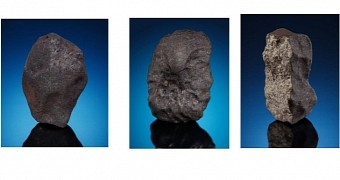Come September 28, three meteorite fragments will be auctioned off in the city of Dallas in Texas, US. The fragments are not native to US soil, so to speak. They were brought to this country all the way from Russia.
Auction house Heritage Auction, which is in charge of organizing the sale during which the meteorite fragments will hopefully find new, loving families, expects that the space pebbles will sell for several hundred dollars, Space informs.
In fact, the opening bids for the three space rocks are $500 (€386), $2,500 (€1,930), and $4,000 (€3,088), respectively. These selling prices were established depending on the rocks' size, makeup, and condition.
So, where do these meteorite fragments come from?
As mentioned, the space rock fragments Heritage Auction will sell later this month were brought to the US from Russia. They originate from a meteorite that exploded over this country towards the beginning of last year.
Thus, it was on February 15, 2013, that a massive space rock entered our planet's atmosphere and made its way towards Russia's Chelyabinsk region. The meteorite exploded before reaching land, and bits and pieces of it went flying through the air.
The meteorite fragments resulting from this blast caused extensive damage to local infrastructure. What's more, hundreds of people were injured and required urgent medical attention, and telecommunication systems were out of order for several hours.
The Russian meteorite in numbers
The space rock that went "kaboom" over Russia's Chelyabinsk region last year is estimated to have measured about 20 meters in diameter (roughly 65.5 feet). It weighed about 13,000 – 14,000 tons, which means that it was significantly heavier than the Eiffel Tower.
It is estimated that, when exploding, the space rock released about as much energy as detonating 500 kilotons of TNT all at once would. Luckily, most of this energy was absorbed by our planet's atmosphere. Otherwise, the blast would have caused much more damage than it did.
Are there any other meteorite fragments out there?
When the so-called Chelyabinsk meteorite exploded over Russia on February 15, 2013, dozens of space rock fragments ended up scattered all around the site of the blast. Of these fragments, some were picked up by scientists, and others by regular folks.
Scientists will likely hold on to the space rock fragments they have managed to acquire for research purposes. Otherwise put, there is no way that they will agree to sell them and thus miss the chance to study them in detail, looking for clues about the makeup of the universe.
As far as the rocks picked up by regular folks are concerned, it's safe to assume that, but for collectors, many will try to make a few bucks by selling them. Hence, we should expect to hear about other meteorite fragments being auctioned off in the months, maybe even the years to come.

 14 DAY TRIAL //
14 DAY TRIAL //